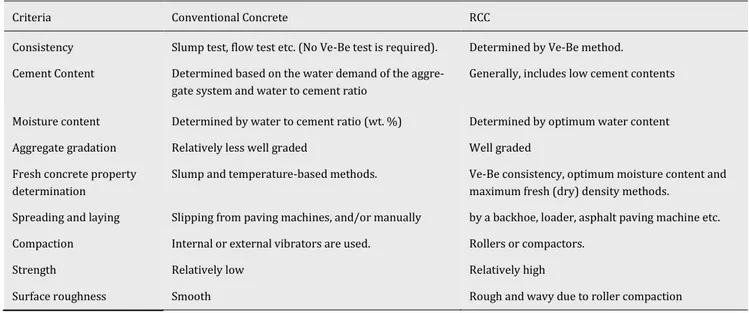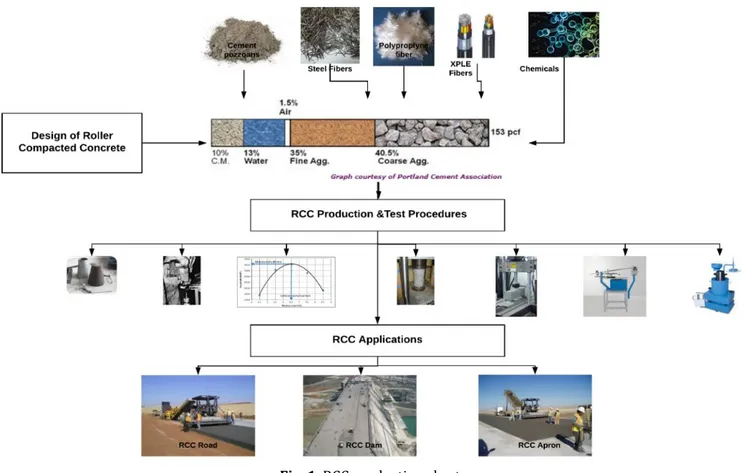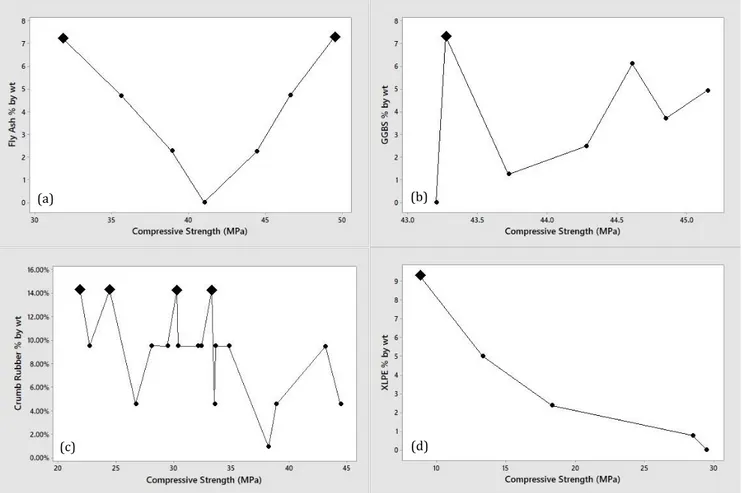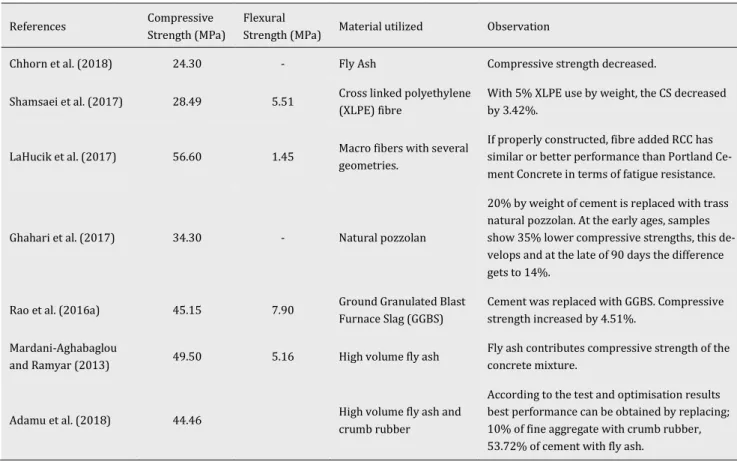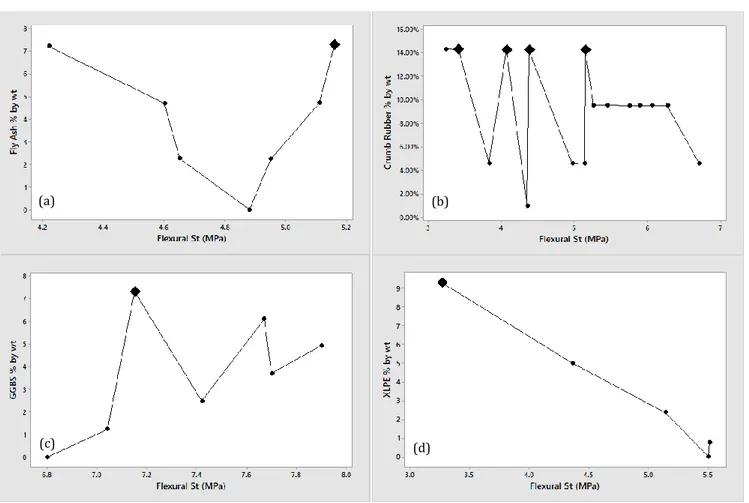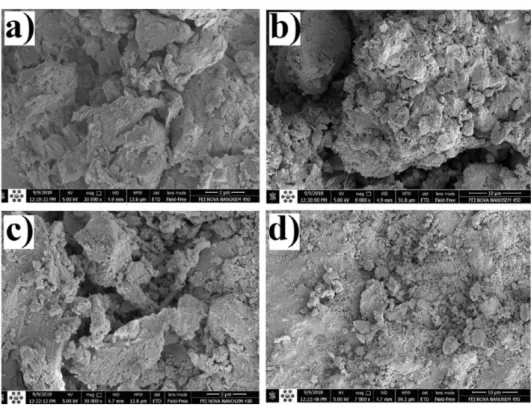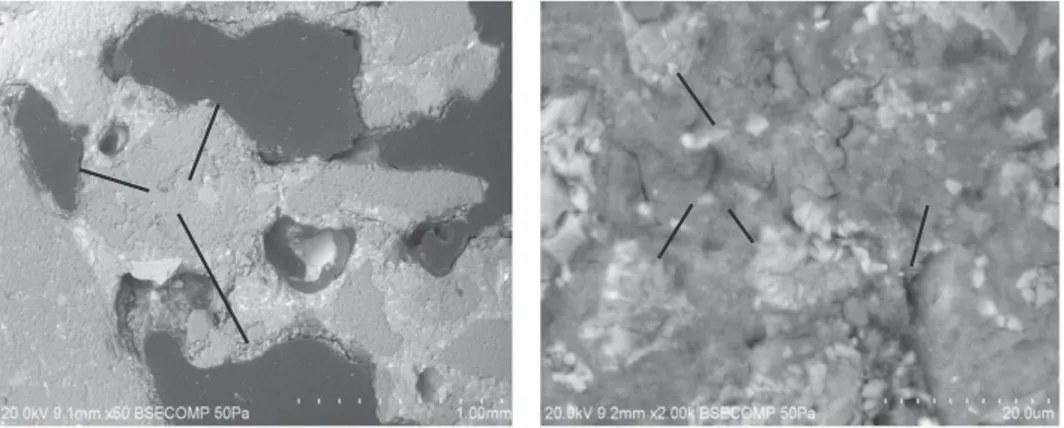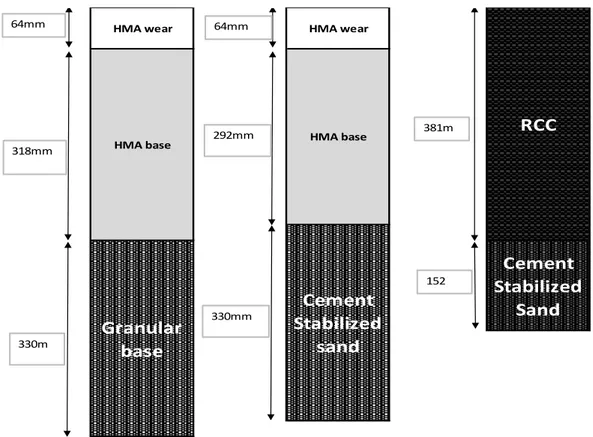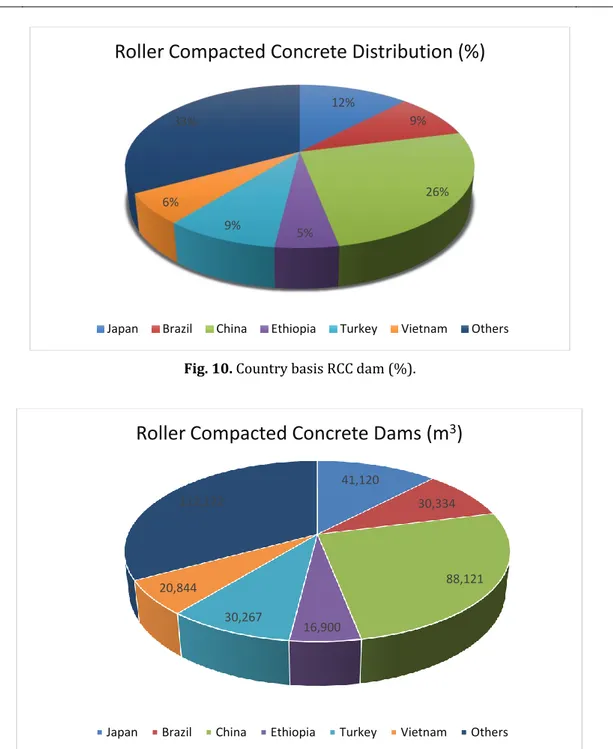* Corresponding author. Tel.: +90-338-226-2000 ; Fax: +90-338-226-2023 ; E-mail address: gokhancalis@kmu.edu.tr (G. Calis) ISSN: 2548-0928 / DOI: https://doi.org/10.20528/cjcrl.2019.03.003
Review
Investigation of roller compacted concrete: Literature review
Gokhan Calis
*
, Sadık Alper Yıldızel
Department of Civil Engineering, Karamanoğlu Mehmetbey University, 70100 Karaman, Turkey
ABSTRACT
Roller compacted concrete is a type of zero slump product produced from the same materials with conventional concrete. There are various methods for the design of RCC namely; corps of engineers’ practice, high paste method, roller compacted dam method and maximum density method. Development of RCC has led a significant shift in the construction projects primarily in dams as the traditional practise of placing, compacting and consolidation is slow. By using RCC in earth and rock filled dams made the construction process quicker and consequently shortened the duration of construction. RCC used dam projects and be completed 1-2 years earlier than the other dams as mentioned in the article of Bagheri and Ghaemian (2004). Use of RCC has substantially increased in the last decades especially for pavement applications. It has a low construction cost and can be done quickly compared to asphalt. It is widely constructed in areas/ roads carrying heavy loads in low speed. On the other hand, in recent years' utilization of RCC in urban areas such as highways and streets has also increased. It has been proved that RCC has a competitive advantage over high performance asphalt pavements in terms of high compressive strength, durabil-ity, low maintenance cost, longer service life. Like conventional concrete, fibre addi-tion is widely preferred in RCC as well. Fibre addiaddi-tion has contribuaddi-tion to mechanical properties of RCC and sustainability.
ARTICLE INFO Article history: Received 2 August 2019 Revised 28 August 2019 Accepted 3 September 2019 Keywords:
Roller compacted concrete Concrete road
Roller compacted concrete applications Concrete characteristics
1. Introduction
Roller compacted concrete (RCC) has been commonly used by many contractors in infrastructures, hydraulic structures and pavement applications as shown by Wang et al. (2018). In recent years RCC has become a highly preferred application especially in urban areas accord-ing to Williams (2014). RCC contains the same accord- ingredi-ents; well graded aggregates, cementitious materials, and water, just like conventional concrete. The main dif-ference between RCC and traditional concrete is the mix-ture propositions. RCC is a zero-slum concrete that is placed with the help of a compactor, additionally vibra-tory rollers are also needed in the process to generate high strength and durability in the concrete. RCC con-tains a larger percentage of fine aggregates in compari-son to standard concrete and this can be seen as the main difference from conventional concrete as stated by Jones (2012). This enables RCC to have tight packing and better
consolidation (ACI 327, 2015). Amount of cement used in RCC mixture is also lower than typical Portland Ce-ment Concrete. RCC contains 12% ceCe-mentitious material by weight, while PCC has 15%. The type of cementitious material has a vital influence on the rate of hydration and strength development. Therefore, Type II Portland ce-ment is widely preferred in RCC. It is noted that the qual-ity of aggregate and water affect the strength of RCC (Luhr, 2000). RCC and conventional concrete compari-son is given in Table 1.
RCC has been used for various purposes with different applications due to its simple applications. It is em-ployed in container yards, dams, airports, logistical areas such as; freight terminals, logistic centre and highways. It is widely preferred to be used in highways as an alter-native option to asphalt. When it is applied as highway or road pavements, the traffic can be opened reasonably in a short time (Mohammed, 2018). Therefore, it is a time saving application. Formwork, surface finishing, dowelled
joints or reinforcement is not required for RCC. In this respect RCC can be considered as economical and fast (Berry and Tayabji, 2001).
This study aims to review the literature in terms of the content of RCC (both fibres added, and non-fi-bre added), utilisation of RCC, and advantages of its
applications in the construction projects. Besides, within the scope of this study RCC is reviewed by con-sidering 4 factors which are; environmental effect, cost, fibre addition, country basis RCC use. In this re-spect, this study is unique and provides useful data to the researchers.
Table 1. RCC comparison with conventional concrete (Hazaree, 2007).
Criteria Conventional Concrete RCC
Consistency Slump test, flow test etc. (No Ve-Be test is required). Determined by Ve-Be method. Cement Content Determined based on the water demand of the
aggre-gate system and water to cement ratio
Generally, includes low cement contents
Moisture content Determined by water to cement ratio (wt. %) Determined by optimum water content Aggregate gradation Relatively less well graded Well graded
Fresh concrete property determination
Slump and temperature-based methods. Ve-Be consistency, optimum moisture content and maximum fresh (dry) density methods.
Spreading and laying Slipping from paving machines, and/or manually by a backhoe, loader, asphalt paving machine etc. Compaction Internal or external vibrators are used. Rollers or compactors.
Strength Relatively low Relatively high
Surface roughness Smooth Rough and wavy due to roller compaction
Researchers have paid significant attention to RCC which is a type of zero slump product that is produced from the same materials with conventional concrete (Madhkhan et al., 2012). There are various applications of RCC in terms of cement amount contents. The sug-gested amount without any pozzolanic material utiliza-tion is 66 kg/m3 (ACI 327, 2015). However the most com-monly used cement amount in RCC mixtures within the range of 100 kg/m3 and 200 kg/m3 (Mardani-Aghabaglou and Ramyar, 2013). There are four typical methods for the design of RCC namely; corps of engi-neers’ practice, high paste method, roller compacted dam method and maximum density method. These prac-tices can be summarised as follows:
Corps of Engineers Method: This method is based on
the W/C ratio and strength relationships. The amounts of water and maximum sizes of aggregates are depend-ent on the desired strength (Aghabaglou et al., 2019).
RCC Dam Method: It has 2 principles.
The amount of cement must be as low as possible while having the desired strength. Furthermore, the mixture must contain flying ash in order to decrease hydration temperature.
In order to prevent segregation and have more effective compaction sand/aggregate ratio must be higher than traditional mass concrete (Aghabaglou et al., 2019).
High Paste Method: This method requires to follow 3
steps;
Under specific compaction energy, minimum grada-tion aggregate selecgrada-tion required;
In order to obtain the required workability, the vol-ume of the paste is determined by considering the gap volume between aggregates;
In order to gain the necessary strength, water/cement ratio and pozzolanic content should be determined. Dry weight and water content are calculated.
Maximum Density Method: 90% of this mix by volume
is formed by aggregate (both coarse and fine). Therefore, firstly aggregate is selected from the table (Aghabaglou et al., 2019).
Like the standard concrete, the strength of RCC de-pends on numerous factors namely; cement type, aggre-gate type, compaction, RCC strength and ambition condi-tions (Chhorn et al., 2018). These are all site condicondi-tions. As mentioned earlier, RCC roads can be opened to traffic earlier than its competitor asphalt. Strength develop-ment of RCC to 20 N/ mm2 has vital role in opening the road as it is the minimum criteria used in the USA (Pig-gott, 1999). In warm weather RCC is capable of develop-ing 20N/mm2 strength within 2 days, in colder days this duration is determined to be 4 days (Toplicic-Curcic et al., 2015).
Development of RCC has led a significant shift in the construction projects primarily in dams, since the tra-ditional practise of placing, compacting and consolida-tion of concrete are slow. By using RCC in earth and rock filled dams made the construction process quicker and consequently shortened the duration of construction. RCC used dam projects and be completed 1-2 years earlier than the ones in which conventional methods have been applied (Bagheri and Ghaemian, 2004).
Use of RCC has substantially increased in the last dec-ades especially for pavement applications. It has a low construction cost and can be quickly constructed when compared to asphalt pavements. It is widely constructed in areas/ roads carrying heavy loads in low speed. On the other hand, in recent years' utilization of RCC in urban areas such as highways and streets has also increased (Harrington et al., 2010; LaHucik et al., 2017).
It has been proved that RCC has a competitive ad-vantage over high performance asphalt pavements in terms of high compressive strength, durability, low maintenance cost, longer service life. Even though its share in the construction market is relatively low, it has gained significance in recent years. As a result of this growing interest in RCC applications, design methods have increased in recent years as well.
2. Characteristics of RCC
Overall, RCC is quite similar to conventional concrete in terms of ingredients and expected properties from it such as compressive & flexural strength, abrasion re-sistance etc. However, it has been proven that mechani-cal properties such as compressive, flexural strength,
shear strength and toughness can be higher than tradi-tional concrete (Madhkhan et al., 2015).
RCC differs from conventional concrete in terms of the required consistency which has a direct influence on the mix proportion requirement Khayat and Libre (2014). Compaction process has an essential role in the load car-rying capacity of RCC as it creates friction between the aggregates or the particles (Hashemi et al., 2018). There are two main approaches to design RCC.
There are researches that observed compressive, flex-ural and tensile strength of RCC under the impact of dif-ferent fibre or mixture material. These will be reviewed in the following sections. A brief summary of RCC pro-duction is shown in Fig. 1.
2.1. Workability and setting times
Workability and consistency of standard concrete are determined via the slump test. However, this test can’t measure the workability of RCC. Ve-Be time is used to express workability for RCC concrete (ACI 327, 2015). It is suggested to have 20 up to 75 seconds of Ve-Be time in order to compactable concrete (Chhorn et al., 2018). Ve-Be time suggestions for RCC can be seen in Table 2.
Fig. 1. RCC production chart.
Table 2. Recommended Ve-Be times and water content (Chhorn et al., 2018).
Modified Ve-Be times (s) Optimum water content (%)
- 5 - 8
20 second for rollability, 30-40 is acceptable 4.5 – 6.5 30-40 seconds: appropriate -
Addition of cross-linked polyethylene (XLPE) fibers have a positive effect on the workability of RCC and, Ve-Be times decrease with the increasing XLPE contents Shamsaei, Aghayan and Kazemi (2017). Natural pozzo-lan inclusion to RCC mixtures resulted in a decrease of Ve-Be time and workability property (Ghahari et al., 2017). Similarly with the addition of polypropylene fi-bre, workability decreases as reported in a study (Be-nouadah et al., 2017). This can be attributed to the high water absorption properties of natural pozzolans. 2.2. Evaluation of compressive strength
Compressive strength is a vital property for conven-tional concrete with or without fibre inclusion (Auta et al., 2015; Kiyanets, 2018). Like conventional concrete, RCC requires to conduct a compressive strength test. This test is performed with the combined conduction of vibrating table ASTM C1176-92, proctor ASTM C1557, coring tests ASTM C42. It is determined that 28 Days compressive strength of RCC cannot be less than 28
MPa (ACPA American Concrete Pavement Association, 2014).
Salt scaling that occurs due to saline solutions such as de-icer salt scaling is a common problem with RCC. A re-cent study by (Ghahari et al., 2017) investigated the ef-fects of having pozzolan as cementitious material and air entraining agent to deal with salt scaling issue. It has been determined that the used pozzolan material had not increased the compressive strength. In fact, this had led approximately 9% decrease.
Furthermore, with the purpose of reducing the envi-ronmental effects of waste material, cross-linked poly-ethylene (XLPE) was utilized in RCC. XLPE is a widely used material for the insulation of electric wires and ca-bles. According to the research by Shamsaei et al. (2017), utilisation of XLPE with as a replacement of aggregate decreased the unit weight of cement due to its low unit weight. However, it is also observed that the utilisation of XLPE decreased CS (Fig. 2d). Similarly when the amount of crumb rubber has increased, as a result CS de-creased (Fig. 2c) (Adamu et al., 2018).
Fig. 2. Compressive strength of RCC with different content.
In a recent study, ground granulated blast furnace (GBBS) was replaced with cement. It was observed that compressive strength can be improved with the GBBS in-clusion. In fact, GBBS addition can achieve compressive strengths as high as cement contributes (Rao et al., 2016a). Fly ash has a similar impact on RCC compared to the GBBS effects on RCC. When the amount removed from cement, added as fly ash the mixtures have almost
the same compressive strength values. Based on these two experimental studies, it can be deduced that both fly ash and GBBS can be used as the cement replacement materials for RCC designs. Furthermore, when these ad-ditions are included in the concrete the mixtures show almost the same compressive strength results (Fig. 2b).
The effect of steel fibre addition in to RCC mixture was investigated as well. The test results in the recent study
(a) (b)
indicate that utilisation of steel fibre increased compres-sive strength approximately 20-30%. Similarly polypro-line fibre made an incremental impact as well (Madhkhan et al., 2012). In a study efficiency of steel fi-bre in conventional concrete and RCC was investigated. It was observed that steel efficiency in RCC is signifi-cantly higher than in conventional concrete (Karadelis and Lin, 2015). Polypropylene fibre has also similar in-creasing effect on RCC (Benouadah et al., 2017).
However, the other research conducted in Thailand indicate that addition of steel fibre to RCC results in de-crease of compressive strength slightly (Sukontasukkul et al., 2019).
Summary of literature review can be seen in Table 3.
It can be concluded that, having different fibres or components have both incremental and decremental ef-fect on compressive strength of RCC.
Table 3. RCC literature review summary.
References Compressive Strength (MPa)
Flexural
Strength (MPa) Material utilized Observation
Chhorn et al. (2018) 24.30 - Fly Ash Compressive strength decreased. Shamsaei et al. (2017) 28.49 5.51 Cross linked polyethylene
(XLPE) fibre
With 5% XLPE use by weight, the CS decreased by 3.42%.
LaHucik et al. (2017) 56.60 1.45 Macro fibers with several geometries.
If properly constructed, fibre added RCC has similar or better performance than Portland Ce-ment Concrete in terms of fatigue resistance.
Ghahari et al. (2017) 34.30 - Natural pozzolan
20% by weight of cement is replaced with trass natural pozzolan. At the early ages, samples show 35% lower compressive strengths, this de-velops and at the late of 90 days the difference gets to 14%.
Rao et al. (2016a) 45.15 7.90 Ground Granulated Blast Furnace Slag (GGBS)
Cement was replaced with GGBS. Compressive strength increased by 4.51%.
Mardani-Aghabaglou
and Ramyar (2013) 49.50 5.16 High volume fly ash
Fly ash contributes compressive strength of the concrete mixture.
Adamu et al. (2018) 44.46 High volume fly ash and crumb rubber
According to the test and optimisation results best performance can be obtained by replacing; 10% of fine aggregate with crumb rubber, 53.72% of cement with fly ash.
2.3. Evaluation of flexural & tensile strength
Flexural strength of RCC is important for its service quality as it is important for conventional concrete. In the recent study impact of cross-linked polyethylene (XLPE) which is a waste material, in RCC was investi-gated. XLPE was used to replace coarse aggregate with various amounts 5%, 15% and 30%. With 5% of XLPE, the flexural strength of RCC is determined to be lower than the sample 0. The trend with the increase of XLPE for flexural strength is downward as shown in Fig. 3d. However, still these specimens meet the minimum re-quirement of RCC guide (Shamsaei et al., 2017).
In other experimental research cement was replaced with Ground Granulated Blast Furnace Slag (GGBF) with different volumes (10%, 20%, 30%, 40%, 50% and 60%). It was observed that GGBF has an incremental ef-fect on RCC flexural strength (Fig. 3c). When cement is reduced by increasing GGBS, flexural strength goes up. It has a similar effect on split tensile as well. With the in-creased amount of GGBF split tensile shows an increas-ing trend (Rao et al., 2016a). The impact of utilization of
fly ash in RCC showed the same results as well (Fig. 3a) (Mardani-Aghabaglou and Ramyar, 2013).
2.4. Elastic modulus
Modulus of elasticity of RCC is not generally measured from the samples on site. The factors that determine the modulus of elasticity are aggregate type, paste volume age and strength (Omran et al., 2017). Modulus of elas-ticity of RCC is generally similar or higher than the mod-ulus of elasticity of normal concrete with the same amount of cement (Berry and Tayabji, 2001). Fibre addi-tion can increase (Nanni and Johari, 1989), or decrease (Muscalu et al., 2013) Elastic Modulus of RCC. Graphical illustration is shown in Fig. 4.
In the recent study, Elastic Modulus of RCC was inves-tigated in fibre added RCC samples (LaHucik et al., 2017). The sample with fibre made steel shows the greatest Elastic Modulus. It can be seen in the table above. How-ever, unlike the other studies, it was, showed in the study that the inclusion of fibre had no statistical impact on the modulus of elasticity of RCC (LaHucik et al., 2017).
Fig. 3. Flexural strength of RCC with different content.
Fig. 4. Elastic Modulus of RCC with different fibers.
2.5. Durability and microstructure properties of RCC Due to sliding and scraping action of wheels, vehicular movements lead abrasion on the pavements (Rao et al., 2016b). Therefore, abrasion resistance of RCC especially in transportation projects is vital. Abrasion tests are per-formed according to ASTM C944 in order to determine surface resistance of RCC. RCC is placed to the construc-tion site by using finisher and compactor. Owing to its installation method RCC is capable of developing excel-lent durability (Benouadah et al., 2017).
There are a few criteria that measure the abrasion re-sistance of concrete namely; viz., aggregate proportion, type of aggregate (both fine and coarse), strength, mix ratio, fibre content, curing methods and method of the surface to finish (Rao et al., 2016a). According to test sults even though RCC sample had low abrasion re-sistance at an early age, later-on it significantly in-creases. Furthermore, fly ash increase abrasion re-sistance of 30% (Won et al., 2009).In the other study when the cement has been replaced with high volume fly ash, abrasion resistance decreases. It was also determined
0 50 100 150 200 250 Modified Olefin Polypropylne/Polyethylene blend Polypropylene Modified Olefin Steel Fiber
Modulus of Elasticity (GPa)
Fi b e rs (a) (b) (c) (d)
that the addition of crumb rubber as the replacement of aggregate has the same effect on the concrete mix (Adamu et al., 2018).
In the recent study, the effect of cationic asphalt emul-sion as an admixture to RCC was investigated. The design was completed according to density method ASTM D1557. The transport properties of RCC can be devel-oped by adding asphalt. Furthermore asphalt addition reduces the amount of capillary pores, as it is shown in Fig. 5 (Dareyni et al., 2018). It can be easily detected that the capillary pores are filled by asphalt.
Effects of electric arc furnace steel slag incorporation on the mechanical and fracture properties of RCC was in-vestigated. Splitting tensile and compressive strength were determined to be higher than the control mixture (Rooholamini et al., 2019). Microstructure of electric arc furnace steel slag and River used RCC can be seen in Fig. 6(a-d). River filler has denser structure while EAF slag shows rare structure in the comparison. EAF slag is finer and smoother than river filler. It can be deduced that EAF filler has more specific area.
Frost resistance of RCC is significant property for RCC considering the area they are used such as roads and dams. In the recent study effects of rubber and steel fi-bres on frost resistance of RCC was investigated. The test results indicate that either steel fibre or rubber fibre does not improve frost resistance of RCC (Zhang et al., 2018). In Fig. 7, microstructure of steel fiber added RCC can be seen. It is observed that bonding surface of mortar without freeze-thaw cycle is clean. An obvious interface between the steel fibre and mortar is also seen in the SEM analysis photo (Fig. 7).
Glass powder (GP) was used as replacement of ce-ment in RCC and effects have been reviewed. Adding glass powder contributes mechanical properties (com-pressive and flexural strength) of RCC. Increase has been observed especially at later age of 91 and beyond. This could be useful improvement against the weather con-ditions (Omran et al., 2017). Glass has impermeable property, which leads GP included RCC to have lower permeability. In dry condition GP is weakly hydrated (Fig. 8).
Fig. 5. Micro structure of asphalt added RCC (Dareyni et al., 2018).
Fig. 7. Micro structure of fibre added RCC (Zhang et al., 2018).
Fig. 8. Micro structure of glass powder added RCC (Omran et al., 2017). 3. Cost Comparison
RCC is worldwide regarded as low cost material which is derived from its ability to be produced and placed in to construction area owing to its characteristics (Won et al., 2009).. The ratio between mechanical proper-ties of RCC and overall cost of RCC construction, operation and maintenance stages is reasonably good (Bílý et al., 2015). The report was issued in U.S.A indicates that %30 cost saving is possible by using RCC in comparison with asphalt or conventional concrete (Pavement, 1990). The other report on the hand, reviews the practices in the Eu-rope and states that with RCC applications there is cost saving up to %12 (Neocleous et al., 2011). A real case study which was priced in USA indicates that cost of RCC per square yard is 12.35$ while asphalt price is 19.62$
(Damrongwiriyanupap et al., 2012). Other report states that as an alternative to asphalt pavement RCC costs higher (Report, 2015). It is obvious that it is not possible draw a conclusion and claim that RCC or Asphalt cost is lower than the other. In fact, it depends on multiple things such as; the country, concrete production facilities, avail-ability of the raw materials, financial strength of the coun-try (currency exchange rates). Hence to be able to make a decision, it requires deeper investigation and it has to be unique research for the proposed construction work. Fiber addition is limited application throughout the world due to high cost of fibers. However this extra cost can be compensated by the rapid construction of RCC. Recent study indicates that steel fiber RCC leads to both cost saving and construction time by at least 10% and energy consumption by 40% (Neocleous et al., 2011).
Table 4. Cost Comparison from a real construction works bid (Damrongwiriyanupap et al., 2012).
Cost Roller Compacted Concrete Asphalt State-Constructed Asphalt In-Place Bid
Total $29,111 $34,486 $46,961
Cost per square yard $12.35 $14.63 $19.62
4. Environmental Benefits of RCC and Its Asphalt Comparison
Sustainability has become a widespread and common concern in all countries since the late 80’s when it was first mentioned. Term of sustainability can be defined as the uti-lisation of the natural resources by considering the future generations and ensuring that they will have enough re-sources. Therefore, the amount of resource consumption should be reasonable (Yılmaz and Bakış, 2015). Due to re-ducing natural resources environmental concerns and ssitivity of non-governmental organisations’, the focus of en-gineering is now directed towards sustainability. On the
contrary to common perception, advancements in cement production have significantly decreased the CO2 emissions in recent years (Sabnis, 2016). Furthermore, RCC is capable of being a sustainable alternative by reducing the amount of utilised material, saving cost and excavation (Abdo, 2010).
As it can be seen in Fig. 9, RCC can be a valuable solu-tion to the engineering problems. Even after the value engineering process, RCC is still capable of optimizing the value engineered solution by reducing the designed HMA wear and HMA base. Furthermore, with the RCC the depth to be excavated less, this gives side benefits as well. With few works at the site, construction works, less workmanship etc.; easy to open for traffic.
Fig. 9. Sustainable RCC solution considered in a real project (Abdo, 2010).
In this respect, benefits of RCC have been seen by many countries, and the number of RCC dams have in-creased recently (Figs. 10 and 11). USA has been using RCC in military, public and private/industrial projects. The most common area in which RCC used is dams.
RCC use can be an effective way to reduce the utilisa-tion of materials. Less material used more sustainability is achieved. RCC applications can be successful in less en-ergy consumption and results in 40% less enen-ergy use (Neocleous et al., 2011). Furthermore, with the help of
technology in cement production, CO2 emissions can be reduced which consequently leads less mission. Like-wise, with the help of fibre or binding alternatives the amount of cement in the concrete can also be reduced.
The other increasing area of utilisation of RCC is in pavements (Sabnis, 2016). Yet, the overall RCC share in the total paved road length in the United States, which is 45.771 km out of 482,924 km. In other words even one of the larger RCC road builder countries has only 9.5% share in its own country (Reza and Boriboonsomsin, 2015).
RCC
Cement
Stabilized
Sand
Granular
base
HMA baseHMA wear HMA wear
HMA base
Cement
Stabilized
sand
330m 64mm 318mm 330mm 292mm 64mm 381m 152Fig. 10. Country basis RCC dam (%).
Fig. 11. Country basis RCC dam (m3).
5. Conclusions
Workability is a significant criterion for RCC. It is mainly dependent on ; aggregate gradation, water con-tent (Chhorn et al., 2018), fibre addition (Ghahari et al., 2017; Adamu et al., 2018) and pozzolan content (Shamsaei et al., 2017). Therefore, it requires significant attention in the mix and production phases.
In terms of having compressive strength RCC can show satisfactory performance with or without fibre ad-dition. Steel fibre is the most preferred fibre addition that improves its CS and can be a strength improver. In this respect, RCC is alike conventional concrete. Pozzo-lan can be an excellent alternative material as replace-ment of cereplace-ment which results in a decrease in cereplace-ment use.
Fiber inclusion is a practise that done with the pur-pose of increasing properties of RCC. However, in terms of cost, volume of material constructed at site, fiber added RCC is preferred to have the same or less thick-ness than with no fiber content RCC. Recent study indi-cates that fiber addition does not increase the thickness of pavement. In fact the thickness of normal RCC without fibre is determined to be 45.72 cm (18 inch), while fiber added RCC thickness is 35.56 cm (14 inch) (Nanni, 2002). Therefore, fiber addition has positive impact on the layer thickness.
The value and advantages of RCC have been recog-nized by many countries including U.S.A, Japan, and this is increasing. It is widely used in dam projects owing to its mechanical properties, less cement used with the help of pozzolan, less cost and not require tensile strength
12% 9% 26% 5% 9% 6% 33%
Roller Compacted Concrete Distribution (%)
Japan Brazil China Ethiopia Turkey Vietnam Others
41,120 30,334 88,121 16,900 30,267 20,844 112,172
Roller Compacted Concrete Dams (m
3)
(Berga and Buil, 2003). In pavements the reasons for se-lection are quite similar. Due to less cost of RCC, easiness to open to the traffic, high compressive strength, and longer service life are the main reasons for RCC to be pre-ferred. RCC applications both in pavement and dam pro-jects look promising. According to the cost comparison of 1m3, it has a significant advantage over asphalt. How-ever, in order to get a more in-depth view, the total cost of asphalt production and RCC production should be in-vestigated in deep.
RCC application is environment friendly and sustain-able application. Cement can be replaced with pozzolan, required strength can be developed by fibre addition. This results in less cement used and consequently less cement production. However. A deeper investigation should be carried out in order to make a fair comparison of CO2 emission for both RCC and asphalt production phases.
This study investigated the RCC and its use, ad-vantages and disadad-vantages. It is obvious that RCC has its own pros and cons. However, it can be appropriate applications especially in City Street and urban areas.
REFERENCES
Abdo FY (2010). Innovative Sustainable Pavement Solutions. Concrete Sustainability Conference, Dubai, UAE, 101-107.
ACI 327 (2015). Guide to Roller-Compacted Concrete Pavements. American Concrete Institute, 327R.
ACPA (American Concrete Pavement Association) (2014). Roller-Compacted Concrete Guide Specificaiton, pp. 1–29. http://www.acpa.org/wp-content/uploads/2014/11/ACPA- Roller-Compacted-Concrete-Guide-Specification-Version-1.2.pdf.Downloaded on 01-07-2019.
Adamu M, Mohammed BS, Shahir M (2018). Mechanical properties and performance of high volume fly ash roller compacted concrete containing crumb rubber and nano silica. Construction and Building Materials, 171(2018), 521–538.
Aghabaglou AM, BAyqra SH, Ozen S, Altun MG, Faqiri ZA, Ramyar K (2019). Silindirle sıkıştırılmış beton karışımlarının tasarım yöntemleri ve yapılan çalışmalar. Pamukkale Univesity Journal of Engineering Sciences, In Press.
Arizona Department of Transportation (1990). Roller Compacted Concrete Pavement. http://rccpavementcouncil.org/wp-content/uploads/2016/08/Arizona-DOT-RCC.pdf. Downloaded on 01-07-2019.
Auta SM, Shiwua AJ, Tsado TY (2015). Compressive strength of concrete with millet husk ash (MHA) as a partial replacement for cement. Magazine of Civil Engineering, 59(7), 74–79.
Bagheri SY, Ghaemian M (2004). Nonlinear dynamic analysis of lean RCC dams. International Symposium on Dams for a Changing World, Kyoto, Japan, 102-108.
Benouadah A, Beddar M, Meddah A (2017). Physical and mechanical behaviour of a roller compacted concrete reinforced with polypropylene fiber. Journal of Fundamental and Applied Sciences, 9(2), 623-635.
Berga L, Buil JM (2003). Roller Compacted Concrete Dams. Taylor & Francis Group. UK, 30-45.
Berry JR, Tayabji SD (2001). Report on Roller-Compacted Concrete Pavements, 95, 1–32.
Bílý P, Fládr J, Haase M (2015). Experimental verification of properties of roller-compacted concrete for pavements. Advanced Materials Research, (2015), 307-312.
Chhorn C, Hong SJ, Lee SW (2017). Relationship between compressive and tensile strengths of roller-compacted concrete. Journal of Traffic and Transportation Engineering, 5(3), 215–223.
Damrongwiriyanupap N, Liang YC, Xi Y (2012). Application of Roller Compacted Concrete in Colorado’s Roadways. https://rosap.ntl.bts.gov/view/dot/25059. Downloaded on 29-07-2019.
Dareyni M, Moghaddam AM, Delarami A (2018). Effect of cationic asphalt emulsion as an admixture on transport properties of roller-compacted concrete. Construction and Building Materials, 163, 724– 733.
Ghahari SA, Mohammadi A, Ramezanianpour AA (2017). Performance assessment of natural pozzolan roller compacted concrete pavements. Case Studies in Construction Materials, 2017 (7), 82-90. Harrington D, Abdo F, Adaska W (2010). Guide for Roller-Compacted Concrete Pavements. http://trid.trb.org/view.aspx?id=1082276. Downloaded on 10-07-2019.
Hashemi M, Shafigh P, Karim MRBK, Aris CD (2018). The effect of coarse to fine aggregate ratio on the fresh and hardened properties of roller-compacted concrete pavement. Construction and Building Materials, 169, 553–566.
Hazaree CV (2007). Transport properties and freeze-thaw resistance of roller compacted concrete (RCC) for pavement applications. Iowa State University, Iowa, https://lib.dr.iastate.edu/cgi/viewcon-tent.cgi?article=15876&context=rtd. Downloaded on 15-07-2019. Jones D (2012). Advances in Pavement Design through Full-scale
Accelerated Pavement Testing. Taylor & Francis Group, 85-99. Karadelis JN, Lin Y (2015). Flexural strengths and fibre efficiency of
steel-fibre-reinforced, roller-compacted, polymer modified concrete. Construction and Building Materials, 93, 498–505. Khayat KH, Libre NA (2014). Roller Compacted Concrete - Field
Evaluation and Mixture Optimization. National University Transportation Center at Missouri University of Science and Technology.
Kiyanets AV (2018). Concrete with recycled polyethylene terephthalate fiber (Бетон с добавлением фибры из переработанного полиэтилентерефталата). Magazine of Civil Engineering, 8(84), 109–118.
LaHucik J, Dahal S, Roesler J, Amirkhanian AN (2017). Mechanical properties of roller-compacted concrete with macro-fibers. Construction and Building Materials, 135, 440–446.
Luhr DR (2000). Engineering and Design Roller Compacted Concrete. (EM 1110-2-2006), 1–77.
Madhkhan M, Azizkhani R, Torki Harchegani ME (2012). Effects of pozzolans together with steel and polypropylene fibers on mechanical properties of RCC pavements. Construction and Building Materials, 26(1), 102–112.
Madhkhan M, Nowroozi S, Torki ME (2015). Flexural strength of roller compacted concrete pavements reinforced with glass-roved textiles. Structural Engineering and Mechanics, 55(1), 137–160. Mardani-Aghabaglou A, Ramyar K (2013). Mechanical properties of
high-volume fly ash roller compacted concrete designed by maximum density method. Construction and Building Materials, 38, 356-364.
Mohammed HA (2018). Two Layer Roller Compacted Concrete. Ph.D thesis, The University of Nottingham, Notthingham, UK.
Muscalu MT, Andrei R, Budescu M, Taranu N, Flroescu E (2013). Use of Recycled Materials in the Construction of Roller Compacted Concrete (RCC) Pavements. Advanced Materials Research, 649, 262–265.
Nanni A, Johari A (1989). RCC pavement reinforced with steel fibers. Concrete International, 11(3), 64-69.
Neocleous K, Graeff A, Pilakoutas K, Koutselas K (2011). Fibre-reinforced roller compacted concrete transport pavements. Proceedings of the Institution of Civil Engineers: Transport, 164(2), 97–109.
Neocleous K, Pilakoutas K (2011). Steel fibre reinforced roller-compacted pavements: Research and practical experience. 2nd International Conference on Best Practices of Concrete Pavements, Florianopolis, Brazil, 1–12.
Omran A, Harbec D, Hamou AT, Gagne R (2017). Production of roller-compacted concrete using glass powder: Field study. Construction and Building Materials, 133, 450–458.
Piggott RW (1999). Roller Compacted Concrete Pavements - A Study of Long Term Performance. Portland Cement Assocaiation,
http://rccpavementcouncil.org/wp-content/up-loads/2016/08/PCA-Piggot-Long-Term-Performance.pdf. Down-loaded on 10-07-2019.
Rao SK, Sravana P, Rao TC (2016a). Abrasion resistance and mechanical properties of Roller Compacted Concrete with GGBS. Construction and Building Materials, 114, 925–933.
Rao SK, Sravana P, Rao TC (2016b). Investigating the effect of M-sand on abrasion resistance of Roller Compacted Concrete containing GGBS. Construction and Building Materials, 122, 191–201. Report F (2015). Arkansas Demonstration Project : The Use of Roller
Compacted Concrete to Reconstruct a Segment of SH 213 in Fayetteville,https://www.fhwa.dot.gov/hfl/projects/ar_hwy213_r cc.pdf. Downloaded on 17-07-2019.
Reza F, Boriboonsomsin K (2015). Pavements made of concrete with high solar reflectance, Eco-efficient Materials for Mitigating Building Cooling Needs, Elsevier, USA.
Rooholamini H, Sedghi R, Ghobadipour B, Adresi M (2019). Effect of electric arc furnace steel slag on the mechanical and fracture properties of roller-compacted concrete. Construction and Building Materials, 211, 88–98.
Sabnis GM (2016). Green Building with Concrete Sustainable Design and Construction. Taylor & Francis Group, USA.
Shamsaei M, Aghayan I, Kazemi KA (2017). Experimental investigation of using cross-linked polyethylene waste as aggregate in roller compacted concrete pavement. Journal of Cleaner Production, 165, 290–297.
Sukontasukkul P, Ghaisakulkiet U, Jamsawang P (2019). Case investigation on application of steel fibers in roller compacted concrete pavement in Thailand. Case Studies in Construction Materials, 11, 271-282.
Toplicic-Curcic G, Grdic D, Ristic N, Grdic Z (2015). Properties, materials and durability of rolled compacted concrete for pavements. Zastita Materijala, 56(3), 345–353.
Transportation Research Record (2002). Transportation Research Record Library, California, USA. http://onlinepubs.trb.org/Onlinepubs/trr/1989/1226/1226-009.pdf. Downloaded on 01-07-2019.
Wang C, Wensu H, Hong Z, Sogn R (2018). Experimental investigations of dynamic compressive properties of roller compacted concrete (RCC). Construction and Building Materials, 168, 671–682. Williams SG (2014). Construction of Roller-Compacted Concrete
Pavement in the Fayetteville Shale Play Area, Arkansas. Transportation Research Record. Journal of the Transportation Research Board, Arkansas, USA, 1-21.
Won JP, Jang C, Lee SW, Kim WY (2009). Durability performance of roller compacted concrete using fly ash. Brittle Matrix Composites 9, Warsaw, Poland, 161-167.
Yılmaz M, Bakış A (2015). Sustainability in Construction Sector. Procedia - Social and Behavioral Sciences, 195, 2253–2262. Zhang W, Gong S, Zhang J (2018). Effect of rubber particles and steel
fibers on frost resistance of roller compacted concrete in potassium acetate solution. Construction and Building Materials, 187, 752–759.
